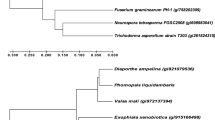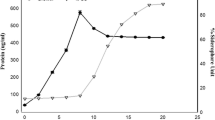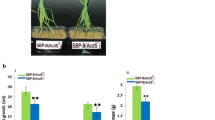Abstract
The present study provides data on the insertion of an extra copy of phytochelatin synthase (alr0975) in Anabaena sp. PCC 7120. The recombinant strain (AnFPN-pcs) compared to wild type showed approximately 22.3% increase in growth rate under UV-B, NaCl, heat, CuCl2, carbofuran, and CdCl2. It also registered 2.25-fold enhanced nitrogenase activity and 5-fold higher phytochelatin production. A comparison of the protein profile of wild type with the recombinant strain revealed that recombinant strain accumulated proteins belonging to the following categories: (i) detoxification (nutrient stress induced DNA binding protein, Mn-SOD, Alr0946 (CalA)), (ii) protein folding and modification (molecular chaperone DnaK, FKBP-type peptidyl-prolyl cis-trans isomerase), (iii) nucleotide and amino acid biosynthesis (dihydroorotase and Ketol-acid reductoisomerase), (iv) photosynthesis and respiration (coproporphyrinogen III oxidase, phycocyanin alpha chain, ferredoxin-NADP+ reductase), and (v) transport (sugar transport ATP-binding protein). Thus, it can be concluded that, above category proteins with their respective role in scavenging reactive oxygen species, proper folding of unfolded proteins, and protection of protein from degradation, sustained carbon fixation and energy pool and active transport of sugar together conceivably help the recombinant cyanobacterium (AnFPN-pcs) to cope with abiotic stress employed in the present study. Such recombinant strains have potential for future use as biofertilizer.





Similar content being viewed by others
References
Agervald Å, Baebprasert W, Zhang X, Incharoensakdi A, Lindblad P, Stensjö K (2010a) The CyAbrB transcription factor CalA regulates the iron superoxide dismutase in Nostoc sp. strain PCC 7120. Environ Microbiol 12:2826–2837. doi:10.1111/j.1462-2920.2010.02255.x
Agervald Å, Zhang X, Stensjo K, Devine E, Lindblad P (2010b) CalA, a cyanobacterial AbrB protein, interacts with the upstream region of hypC and acts as a repressor of its transcription in the cyanobacterium Nostoc sp. strain PCC 7120. Appl Environ Microbiol 76:880–890. doi:10.1111/j.1462-2920.2010.02255.x
Agrawal C, Sen S, Singh S, Rai S, Singh PK, Singh VK, Rai LC (2014) Comparative proteomics reveals association of early accumulated proteins in conferring butachlor tolerance in three N2-fixing Anabaena spp. J Proteomics 96:271–290
Allen MM, Smith AJ (1969) Nitrogen chlorosis in blue-green algae. Arch Microbiol 69:114–120. doi:10.1007/BF00409755
Bhargava P, Mishra Y, Srivastava AK, Narayan OP, Rai LC (2008) Excess copper induces anoxygenic photosynthesis in Anabaena doliolum: a homology based proteomic assessment of its survival strategy. Photosynth Res 96:61–74. doi:10.1007/s11120-007-9285-7
Bhargava P, Srivastava AK, Rai LC, Snigdha U (2005) Phytochelatin plays a role in UV-B tolerance in N2-fixing cyanobacterium Anabaena doliolum. J Plant Physiol 162:1220–1225. doi:10.1016/j.jplph.2004.12.006
Bolchi A, Ruotolo R, Marchini G, Vurro E, Sanità di Toppi L, Kohler A, Tisserant E, Martin F, Ottonello S (2011) Genome-wide inventory of metal homeostasis-related gene products including a functional phytochelatin synthase in the hypogeous mycorrhizal fungus Tuber melanosporum. Fungal Genet Biol 48:573–584. doi:10.1016/j.fgb.2010.11.003
Boston R, Viitanen P, Vierling E (1996) Molecular chaperones and protein folding in plants. Plant Mol Biol 32:191–222. doi:10.1007/BF00039383
Bradford MM (1976) A rapid and sensitive method for the quantification of microgram quantity of proteins utilizing the principle of protein dye binding. Anal Biochem 72:248–254
Carrillo N, Vallejos RH (1987) Ferredoxin-NADP-oxidoreductase. In: Barber J (ed) Topics in photosynthesis 8. Oxford, Elsevier, New York, Amsterdam, pp. 527–560
Chaurasia AK, Apte SK (2009) Overexpression of the groESL operon enhances the heat and salinity stress tolerance of the nitrogen-fixing cyanobacterium Anabaena sp. strain PCC 7120. Appl Environ Microbiol 75:6008–6012. doi:10.1128/AEM.00838-09
Chaurasia AK, Parasnis A, Apte SK (2008a) An integrative expression vector for strain improvement and environmental applications of the nitrogen fixing cyanobacterium, Anabaena sp. strain PCC 7120. J Microbiol Meth 73:133–141. doi:10.1016/j.mimet.2008.01.013
Chaurasia N, Mishra Y, Rai LC (2008b) Cloning, expression and analysis of phytochelatin synthase (pcs) gene from Anabaena sp. PCC7120 offering multiple stress tolerance in Escherichia coli. Biochem Biophys Res Commun 376:225–230. doi:10.1016/j.bbrc.2008.08.129
Ciriolo MR, Civitareale P, Carri MT, De Martino A, Galiazzo F, Rotilio G (1994) Purification and characterization of Ag, Zn-superoxide dismutase from Saccharomyces cerevisiae exposed to silver. J Biol Chem 269:25783–25787
Cobbett C, Goldsbrough P (2002) Phytochelatins and metallothioneins: roles in heavy metal detoxification and homeostasis. Annu Rev Plant Biol 53:159–182. doi:10.1146/annurev.arplant.53.100301.135154
Cornah JE, Smith AG (2009) Transformation of uroporphyrinogen III into protoheme. In:Warren MJ and Smith AG (eds) Tetrapyrroles: birth, life and death, Landes Bioscience and Springer Science Business Media, Austin, pp 74–88.
Gekeler W, Grill E, Winnacker EL, Zenk MH (1989) Survey of the plant kingdom for the ability to bind heavy metals through phytochelatins. Z Naturforsch 44:361–369. doi:10.1093/jxb/erf107
Grill E, Loffler S, Winnacker EL, Zenk MH (1989) Phytochelatins, the heavy metal-binding peptides of plants are synthesized from glutathione by a specific γ-glutamylcysteinedipeptidyltranspeptidase (phytochelatin synthase). Proc Natl Acad Sci U S A 86:6838–6842
Grill E, Winnacker E-L, Zenk MH (1987) Phytochelatins, a class of heavy-metal-binding peptides from plants, are functionally analogous to metallothioneins. Proc Natl Acad Sci U S A 84:439–443
Ha SB, Smith AP, Howden R, Dietrich WM, Bugg S, O’Connell MJ, Goldsbrough PB, Cobbett CS (1999) Phytochelatin synthase genes from Arabidopsis and the yeast, Schizosaccharomyces pombe. Plant Cell 11:1153–1164. doi:10.1105/tpc.11.6.1153
Hall JL (2002) Cellular mechanisms for heavy metal detoxification and tolerance. J Exp Bot 53:1–11
Kneer R, Kutchan TM, Hochberger A, Zenk MH (1992) Saccharomyces cerevisiae and Neurospora crassa contain heavy metal sequestering phytochelatin. Arch Microbiol 157:305–310. doi:10.1007/BF00248673
Liu WY, Wang MM, Huang J, Tang HJ, Lan HX, Zhang HS (2009) The OsDHODH1 gene is involved in salt and drought tolerance in rice. J Integr Plant Biol 51:825–833. doi:10.1111/j.1744-7909.2009.00853.x
Mallick N, Pandey S, Rai LC (1994) Involvement of a cadmium-induced low molecular weight protein in regulating cadmium toxicity in the diazotrophic cyanobacterium Anabaena doliolum. Biometals 7:299–304. doi:10.1007/BF00144125
Marchler-Bauer A, Derbyshire MK, Gonzales NR, Lu S, Chitsaz F, Geer LY, Geer RC, He J, Gwadz M, Hurwitz DI, Lanczycki CJ, Lu F, Marchler GH, Song JS, Thanki N, Wang Z, Yamashita RA, Zhang D, Zheng C, Bryant SH (2015) CDD: NCBI’s conserved domain database. Nucleic Acids Res 43(Database issue):D222–D226. doi:10.1093/nar/gku1221
Mehra RK, Tarbet EB, Gray WR, Winge DR (1988) Metal-specific synthesis of two metallothioneins and γ-glutamil peptides in Candida glabrata. Proc Natl Acad Sci U S A 85:8815–8819
Mishra Y, Chaurasia N, Rai LC (2009) AhpC (alkyl hydroperoxide reductase) from Anabaena sp. PCC 7120 protects Escherichia coli from multiple abiotic stresses. Biochem Biophy Res Commun 381:606–611. doi:10.1016/j.bbrc.2009.02.100
Narayan OP, Kumari N, Bhargava P, Rajaram H, Rai LC (2016) A single gene all3940 (dps) overexpression in Anabaena sp. PCC 7120 confers multiple abiotic stress tolerance via proteomic alterations. Funct Integr Genomics 16:67–78. doi:10.1007/s10142-015-0467-7
Narayan OP, Kumari N, Rai LC (2010) Heterologous expression of Anabaena sp. PCC 7120 all3940 (a dps family gene) protects Escherichia coli from nutrient limitation and abiotic stresses. Biochem Biophy Res Commun 394:163–169. doi:10.1016/j.bbrc.2010.02.135
Padhy RN, Mohapatra K (2001) Toxicity of two carbamate insecticides to the cyanobacterium anabaena PCC 7120 and computations of partial lethal concentrations by the probit method. Microbios 106:81–95
Pandey S, Rai R, Rai LC (2012) Proteomics combines morphological, physiological and biochemical attributes to unravel the survival strategy of Anabaena sp. PCC7120 under arsenic stress. J Proteomics 75:921–937
Pawlik-Skowrońska B (2001) Phytochelatin production in freshwater algae Stigeoclonium in response to heavy metals contained in mining water; effects of some environmental factors. Aquat Toxicol 52(3–4):241–249
Pawlik-Skowrońska B, Pirszel J, Brown MT (2007) Concentrations of phytochelatins and glutathione found in natural assemblages of seaweeds depend on species and metal concentrations of the habitat. Aquat Toxicol 83:190–199. doi:10.1016/j.aquatox.2007.04.003
Pawlik-Skowrońska B, Sanità di Toppi L, Favali MA, Fossati F, Pirszel J, Skowroński T (2002) Lichens respond to heavy metals by phytochelatin synthesis. New Phytol 156:95–102. doi:10.1046/j.1469-8137.2002.00498.x
Rai S, Agrawal C, Shrivastava AK, Singh PK, Rai LC (2014) Comparative proteomics unveils cross species variations in anabaena under salt stress. J Proteomics 98:254–270. doi:10.1016/j.jprot.2013.12.020
Rajaram H, Apte SK (2008) Nitrogen status and heat-stress dependent differential expression of the cpn60 chaperonin gene influences thermotolerance in the cyanobacterium Anabaena. Microbiology 154:317–325. doi:10.1099/mic.0.2007/011064-0
Richaud C, Zabulon G, Jodder A, Thomas JC (2001) Nitrogen and sulphur starvation differentially affects phycobilisomes degradation and expression of the nblA gene in Synechocystis sp. strain PCC 6803. J Bacteriol 183:2989–2994. doi:10.1128/JB.183.10.2989-2994.2001
Rippka R, Deruelles J, Waterbury JB, Herdman M, Stanier RY (1979) Generic assignments, strain histories and properties of pure cultures of cyanobacteria. J Gen Microbiol 111:–61. doi:10.1099/00221287-111-1-1
Saeed AI, Sharov V, White J, Li J, Liang W, Bhagabati N, Braisted J, Klapa M, Currier T, Thiagarajan M, Sturn A, Snuffin M, Rezantsev A, Popov D, Ryltsov A, Kostukovich E, Borisovsky I, Liu Z, Vinsavich A, Trush V, Quackenbush J (2003) TM4: a free, open-source system for microarray data management and analysis. Biotechnol 34:374–378
Sambrook J, Russell DW (2001) Molecular cloning: a laboratory manual. Cold Spring Harbor Laboratory Press. Cold Spring Harbor, New York
Seckbach J and Oren A (2007). Oxygenic photosynthetic microorganisms in extreme environments: possibilities and limitations. Seckbach J (Ed.) Algae and Cyanobacteria in Extreme Environments, pp 3–25, Springer Netherlands.
Sehrautemeier B, Bohme H, Boger P (1984) In vitro studies on pathways and regulation of electron transport to nitrogenase with a cell-free extract from, heterocysts of Anabaena variabilis. Arch Microbiol 137:14–20. doi:10.1007/BF00425801
Seki M, Kamei A, Yamaguchi-Shinozaki K, Shinozaki K (2003) Molecular responses to drought, salinity and frost: common and different paths for plant protection. Curr Opin Biotechnol 14:194–199. doi:10.1016/S0958-1669(03)00030-2
Shrivastava AK, Chatterjee A, Yadav S, Singh PK, Singh S, Rai LC (2015) UV-B stress induced metabolic rearrangements explored with comparative proteomics in three Anabaena species. J Proteomics 127:122–133. doi:10.1016/j.jprot.2015.05.014
Shrivastava AK, Pandey S, Yadav S, Mishra Y, Singh PK, Rai R, Singh S, Rai S, Rai LC (2016) Comparative proteomics of wild type, An+ahpC and An∆ahpC strains of Anabaena sp. PCC7120 demonstrates AhpC mediated augmentation of photosynthesis, N2-fixation and modulation of regulatory network of antioxidative proteins. J Proteomics 140:81–99. doi:10.1016/j.jprot.2016.04.004
Singh PK, Shrivastava AK, Chatterjee A, Pandey S, Rai S, Singh S, Rai C (2015) Cadmium toxicity in diazotrophic Anabaena spp. adjudged by hasty up-accumulation of transporter and signaling and severe down-accumulation of nitrogen metabolism proteins. J Proteomics 127:134–146. doi:10.1016/j.jprot.2015.05.019
Srivastava AK, Ara A, Bhargava P, Mishra Y, Rai SP, Rai LC (2007) A rapid and cost-effective method of genomic DNA isolation from cyanobacterial culture, mat and soil suitable for genomic fingerprinting and community analysis. J Appl Phycol 19:373–382. doi:10.1007/s10811-006-9144-5
Stewart WDP, Fitzgerald GP, Burris RH (1968) Acetylene reduction by nitrogen-fixing blue-green algae. Arch Mikrobiol 62(4):336–348
Tognetti VB, Palatnik JF, Fillat MF, Melzer M, Hajirezaei MR, Valle EM, Carrillo N (2006) Functional replacement of ferredoxin by a cyanobacterial flavodoxin in tobacco confers broad-range stress tolerance. Plant Cell 18:2035–2050
Tognetti VB, Zurbriggen MD, Morandi EN, Fillat MF, Valle EM, Hajirezaei MR, Carrillo N (2007) Enhanced plant tolerance to iron starvation by functional substitution of chloroplast ferredoxin with a bacterial flavodoxin. Proc Natl Acad Sci USA 104 (27):11495–11500
Tsuji N, Nishikori S, Iwabe O, Shiraki K, Miyasaka H, Takagi M, Hirata K, Miyamoto K (2004) Characterization of phytochelatin synthase-like protein encoded by alr0975 from a prokaryote, Nostoc sp. PCC 7120. Biochem Biophys Res Commun 315:751–755. doi:10.1016/j.bbrc.2004.01.122
Vallon O (2005) Chlamydomonas Immunophilins and Parvulins: survey and critical assessment of gene models. Eukary cell 4:230–241. doi:10.1128/EC.4.4.836.2005
Vatamaniuk OK, Mari S, Lu YP, Rea PA (1999) AtPCS1, a phytochelatin synthase from Arabidopsis thaliana: isolation and in vitro reconstitution. Proceedings of the National Academy of Sciences, USA 96:7110–7115. doi:10.1073/pnas.96.12.7110
Wagner T, Windhövel U, Römer S (2002) Transformation of tobacco with a mutated cyanobacterial phytoene desaturase gene confers resistance to bleaching herbicides. Z Natuforsch 57c:671–679
Zhang H, Xu W, Guo J, He Z, Ma M (2005) Coordinated responses of phytochelatins and metallothioneins to heavy metals in garlic seedlings. Plant Sc 169(6):1059–1065
Acknowledgments
L. C. Rai is thankful to CSIR, ICAR, for the financial support; DST, for J C Bose National Fellowship; and DAE for Rajaramanna Fellowship. Neha Chaurasia, Yogesh Mishra, Antra Chatterjee, and Shivam Yadav are thankful to CSIR-UGC JRF. We thank Professor S. K. Apte from BARC Mumbai for providing the pFPN vector. We also thank the Head and Program Coordinator, CAS in Botany, BHU, for the facilities.
Author information
Authors and Affiliations
Corresponding author
Additional information
Handling Editor: Bhumi Nath Tripathi
Electronic supplementary material
ESM 1
(DOCX 1265 kb)
Rights and permissions
About this article
Cite this article
Chaurasia, N., Mishra, Y., Chatterjee, A. et al. Overexpression of phytochelatin synthase (pcs) enhances abiotic stress tolerance by altering the proteome of transformed Anabaena sp. PCC 7120. Protoplasma 254, 1715–1724 (2017). https://doi.org/10.1007/s00709-016-1059-7
Received:
Accepted:
Published:
Issue Date:
DOI: https://doi.org/10.1007/s00709-016-1059-7




